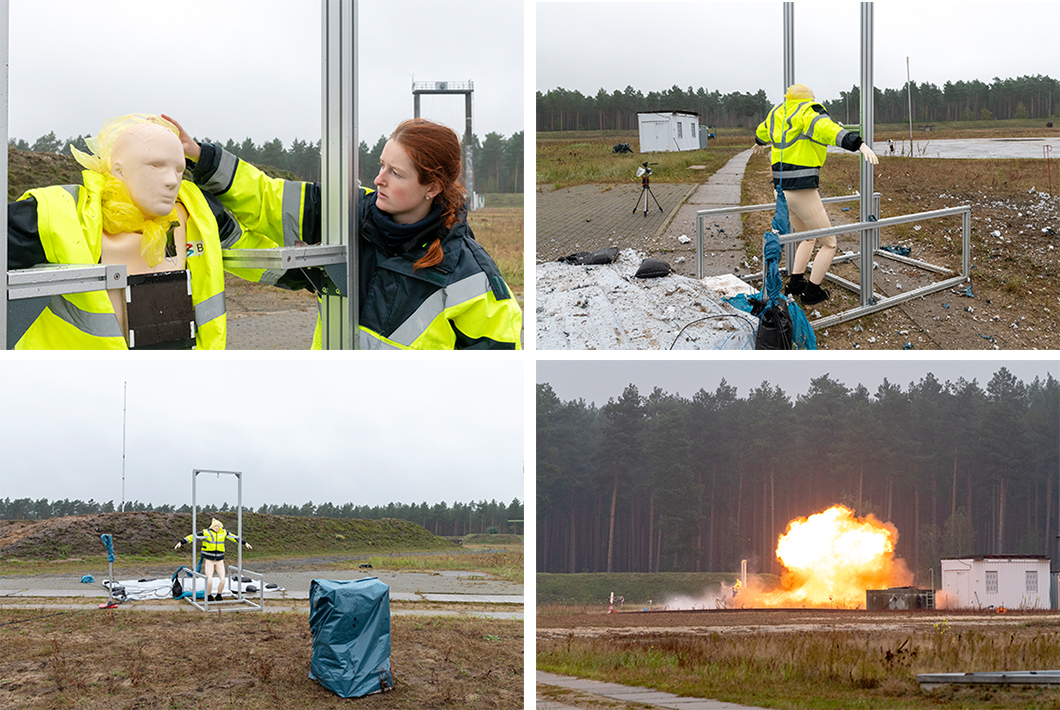
Blasting test with 5kg plastic explosive at BAM's Test Site for Technical Safety
Source: BAM
Large fires, explosions or other disasters require protection models to minimise their impact on people and critical infrastructure. For this purpose, BAMʼs security team is investigating potential damage scenarios to develop suitable protection measures and operational tactics.
Authorities and organisations with safety responsibilities (BOS) such as fire departments, the Federal Agency for Technical Relief (THW) or the police must react quickly in the event of a catastrophe and make rapid decisions to protect the population. However, the emergencies are very diverse and complex: gases may escape at the incident site or previously unknown explosives may have been used. The knowledge available to emergency teams about these potential risks is often insufficient. In addition to all the advantages and opportunities, the transformation to a climate-neutral society is also accompanied by new technologies and materials such as hydrogen, recyclable building materials or electrical energy storage systems, for which there is as yet little or no information available on what to do in the event of an emergency. “What-if” considerations are necessary in order to comprehensively assess the damage potential and extent in the event of disasters,” explains Daniel Krentel, spokesman for BAM’s area of security. “This is a task that BOS cannot accomplish alone. We therefore support them in identifying, analysing and evaluating the potential impacts of fires, explosions and other emergencies to derive and adapt standard operation procedures.” However, not all scenarios can be simulated by computers, but many of them must be tested and validated experimentally to obtain truly robust information. This is best done using full-scale tests.
Pilotplant enables full-scale tests on the impacts of explosions
BAM has excellent facilities on its 12 km² Test Site for Technical Safety in Brandenburg that enables full-scale simulation and investigation of various scenarios. The impacts of improvised explosive devices including homemade booby traps and other terrorist scenarios can also be analysed using available measurement techniques and methods. The team is currently investigating the impacts of detonations on building structures, e.g. walls. The scientists want to develop standardised methods that can be used to determine the residual load-bearing capacity of a building in an emergency and strengthening measures for existing buildings that should also be developed. Non-destructive measurement methods such as fibre-optic sensors, ultrasound, image correlation and acceleration sensors will be used to determine the deformation and damage behaviour of steel girders, concrete ceilings and reinforced concrete walls.
Emphasis on a holistic approach
“Based on the diverse data from the tests, we can comprehensively assess damaged buildings and obtain a much more practical picture than a mere visual inspection or a single method would provide,” explains Daniel Krentel. “Only this holistic approach, which is our guideline, conveys the full extent of an emergency situation.“ In addition to the impacts of explosions on buildings and infrastructure, the security experts are also investigating the consequences on humans.

Blasting test with 5kg plastic explosive at BAM's Test Site for Technical Safety. A special dummy is used to determine the effects of an explosion on humans.
Source: BAM
Tests on special dummies and body models are used for this purpose and impacts of blast on internal organs and tissue will be determined. BAM is developing a basis for understanding the mechanisms of injuries together with physicians from the Bundeswehr Hospital in Berlin. The aim of all the investigations is to develop effective protection concepts together with BOS or to improve existing ones.


